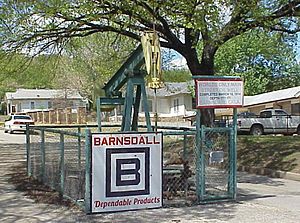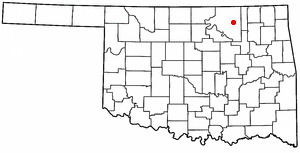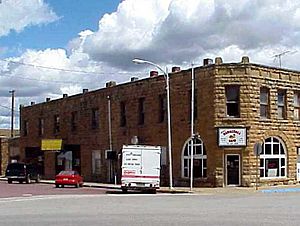Barnsdall, Oklahoma facts for kids
Quick facts for kids
Barnsdall, Oklahoma
|
|
|---|---|

|
|
| Nickname(s):
Bigheart
|
|

Location of Barnsdall in Oklahoma
|
|
| Country | United States |
| State | Oklahoma |
| County | Osage |
| Founded | 1905 (Bigheart) 1922 (Barnsdall) |
| Named for | James Bigheart Theodore Barnsdall |
| Government | |
| • Type | Mayor-council |
| Area | |
| • Total | 1.18 sq mi (3.06 km2) |
| • Land | 0.98 sq mi (2.55 km2) |
| • Water | 0.20 sq mi (0.51 km2) |
| Elevation | 735 ft (224 m) |
| Population
(2020)
|
|
| • Total | 1,034 |
| • Density | 876/sq mi (337.9/km2) |
| Time zone | UTC-6 (Central (CST)) |
| • Summer (DST) | UTC-5 (CDT) |
| ZIP Code |
74002
|
| Area code | 539 / 918 |
| FIPS code | 40-04250 |
| GNIS ID | 2409788 |
Barnsdall is a city in Osage County, Oklahoma, United States. As of the 2020 census, the population of the city was 1,034.
Contents
History
The community was founded in 1905 and originally named Bigheart, for the Osage Chief James Bigheart. It was initially a 160-acre site along the Midland Valley Railroad in March 1905. The railroad opened Bigheart Station in September 1905 and the Bigheart Post Office opened in January 1906. The community was exempted from the Osage allotment, so lots could be sold to anyone. Lots were auctioned in May 1906. The first newspaper, the Bigheart Star, first appeared in 1906.
Joshua Cosden built the Southwest Refining Company oil refinery in 1910. He sold it to Stone and Webster of Boston, Massachusetts in 1917. The Barnsdall Oil Company had discovered the nearby Bigheart (later Barnsdall) oilfield in 1916. The Barnsdall Oil Company, bought the refinery in 1921. The community was renamed Barnsdall on January 1, 1922, in honor of Theodore N. Barnsdall.
Barnsdall experienced a tornado in April 1911, a major fire in March 1913 and a flood in September 1915. Despite these calamities, the population increased from 307 in 1910 to 2,099 in 1920. That proved to be the high point of population in the community.
Henry L. Doherty bought the holdings of Theodore N. Barnsdall, founder of Barnsdall Oil Company, in 1912. Barnsdall Refining Company renamed itself Bareco Oil Company in 1940. It ceased refining oil in 1946 and began producing microcrystalline waxes that year. Petrolite Corporation (later part of Baker Hughes) bought Bareco and continued to operate the plant. The business was sold to SK Capital in September 2020 and renamed NuCera Solutions; and, NuCera was sold in September 2022 to Chase Corporation. NuCera continued as operator until July 2024, when tornado damage lead to announcement of the plant's phased shutdown.
The Midland Valley Railroad trackage both north and south of Barnsdall has been abandoned, the southern portion in 2000. At least some of the route south of Barnsdall has been converted into a rail trail.
2024 tornadoes
On the evening of April 1, 2024, an EF1 tornado struck Barnsdall, damaging 35 homes, but no injuries were reported.
On the evening of May 6, 2024, an EF4 tornado hit the city, the second tornado in the city within five weeks. Peak wind speeds were estimated at 180 mph (290 km/h). Two fatalities occurred in Barnsdall as a result of the tornado, and several structures were completely destroyed. Barnsdall Nursing Home was among the structures that were damaged. Several buildings, including schools, were opened to those who had homes damaged or destroyed and needed shelter. At least ten people reportedly suffered injuries due to the tornado. Significant damage was done to the NuCera refinery.
Geography
Barnsdall is located 17 miles (27 km) southeast of Pawhuska, the Osage County seat, and 40 miles (64 km) northwest of Tulsa.
According to the United States Census Bureau, the city has a total area of 0.6 square miles (1.6 km2), all land.
Climate
| Climate data for Barnsdall, Oklahoma | |||||||||||||
|---|---|---|---|---|---|---|---|---|---|---|---|---|---|
| Month | Jan | Feb | Mar | Apr | May | Jun | Jul | Aug | Sep | Oct | Nov | Dec | Year |
| Mean daily maximum °F (°C) | 46.7 (8.2) |
52.5 (11.4) |
63.1 (17.3) |
74.1 (23.4) |
80.5 (26.9) |
88.3 (31.3) |
94.5 (34.7) |
93.8 (34.3) |
85.2 (29.6) |
75.0 (23.9) |
61.2 (16.2) |
49.7 (9.8) |
72.1 (22.3) |
| Mean daily minimum °F (°C) | 22.5 (−5.3) |
27.4 (−2.6) |
37.0 (2.8) |
48.1 (8.9) |
56.5 (13.6) |
65.2 (18.4) |
69.8 (21.0) |
67.6 (19.8) |
60.3 (15.7) |
48.0 (8.9) |
37.0 (2.8) |
26.4 (−3.1) |
47.2 (8.4) |
| Average precipitation inches (mm) | 1.4 (36) |
1.9 (48) |
3.7 (94) |
3.3 (84) |
4.8 (120) |
4.7 (120) |
2.9 (74) |
3.5 (89) |
5.6 (140) |
3.2 (81) |
3.0 (76) |
1.9 (48) |
39.9 (1,010) |
| Source: Weatherbase.com | |||||||||||||
Demographics
| Historical population | |||
|---|---|---|---|
| Census | Pop. | %± | |
| 1910 | 307 | — | |
| 1920 | 2,099 | 583.7% | |
| 1930 | 2,001 | −4.7% | |
| 1940 | 1,831 | −8.5% | |
| 1950 | 1,708 | −6.7% | |
| 1960 | 1,663 | −2.6% | |
| 1970 | 1,579 | −5.1% | |
| 1980 | 1,501 | −4.9% | |
| 1990 | 1,316 | −12.3% | |
| 2000 | 1,325 | 0.7% | |
| 2010 | 1,243 | −6.2% | |
| 2020 | 1,034 | −16.8% | |
| 2020 Cenus Results | |||
2022 American Community Survey
As of 2022[update] American Community Survey estimates, there were 1,019 people and 360 households. The population density was 1,035.6 inhabitants per square mile (399.8/km2). There were 461 housing units at an average density of 468.5 per square mile (180.9/km2). The racial makeup of the city was 65.6% White, 19.7% Native American or Alaskan Native, and 0.7% Black or African American, with 14.0% from two or more races. Hispanics or Latinos of any race were 5.3% of the population.
Of the 360 households, 26.4% had children under the age of 18 living with them, 35.6% had seniors 65 years or older living with them, 54.2% were married couples living together, 5.8% were couples cohabitating, 11.7% had a male householder with no partner present, and 28.3% had a female householder with no partner present. The median household size was 2.74 and the median family size was 3.42.
The age distribution was 28.0% under 18, 11.4% from 18 to 24, 19.0% from 25 to 44, 21.5% from 45 to 64, and 20.1% who were 65 or older. The median age was 36.8 years. For every 100 females, there were 111.4 males.
The median income for a household was $56,500, with family households having a median income of $67,625 and non-family households $23,516. The per capita income was $23,458. Males working full-time jobs had median earnings of $40,402 compared to $34,688 for females. Out of the 982 people with a determined poverty status, 6.5% were below the poverty line. Further, 2.2% of minors and 4.6% of seniors were below the poverty line.
In the survey, residents self-identified with various ethnic ancestries. People of German descent made up 16.0% of the population of the town, followed by Irish at 14.7%, American at 9.2%, English at 4.9%, Dutch at 2.5%, Caribbean (excluding Hispanics) at 1.4%, Scotch-Irish at 0.8%, and Arab at 0.7%.
Economy
NuCera Solutions was located in Barnsdall, a manufacturer of specialty waxes and polymers and the town's largest employer. On May 6, 2024, the plant sustained severe damage from an EF4 tornado. It was announced on July 30, 2024, that the plant would close permanently in 6–12 months, despite initial efforts to rebuild the plant.
Events
Barnsdall's annual Bigheart Day is held The Saturday before Memorial Day.
Attractions

Barnsdall has two properties listed on the National Register of Historic Places listings in Osage County, Oklahoma:
- Bank of Bigheart, which is the communities oldest commercial building
- Barnsdall Main Street Well Site, an oil well in the middle of Main Street.
In addition, the Woolaroc Ranch Historic District, 8 miles east of the junction of State Highway 11 and State Highway 123, is near Barnsdall.
Notable people
- Anita Bryant (born 1940), singer and political activist, known for anti-gay activism, was born in Barnsdall. She was Miss America runner-up in 1958.
- Clark Gable (1901–1960), movie star famous for his role in "Gone With the Wind", came to Barnsdall with his father for a short while when the community was in the oil business. The native stone shotgun house where he resided on West Walnut Street still stands. Clark was also noted to sing in a quartet while he lived in Bigheart (Barnsdall).
- Thomas Hall (born 1939), retired rear admiral of the United States Navy.
- J. Edward Roush (1920–2004), lawyer, World War II veteran, served eight terms as a U.S. Representative from Indiana from 1959 to 1969, and 1971 to 1977.
See also
 In Spanish: Barnsdall para niños
In Spanish: Barnsdall para niños


